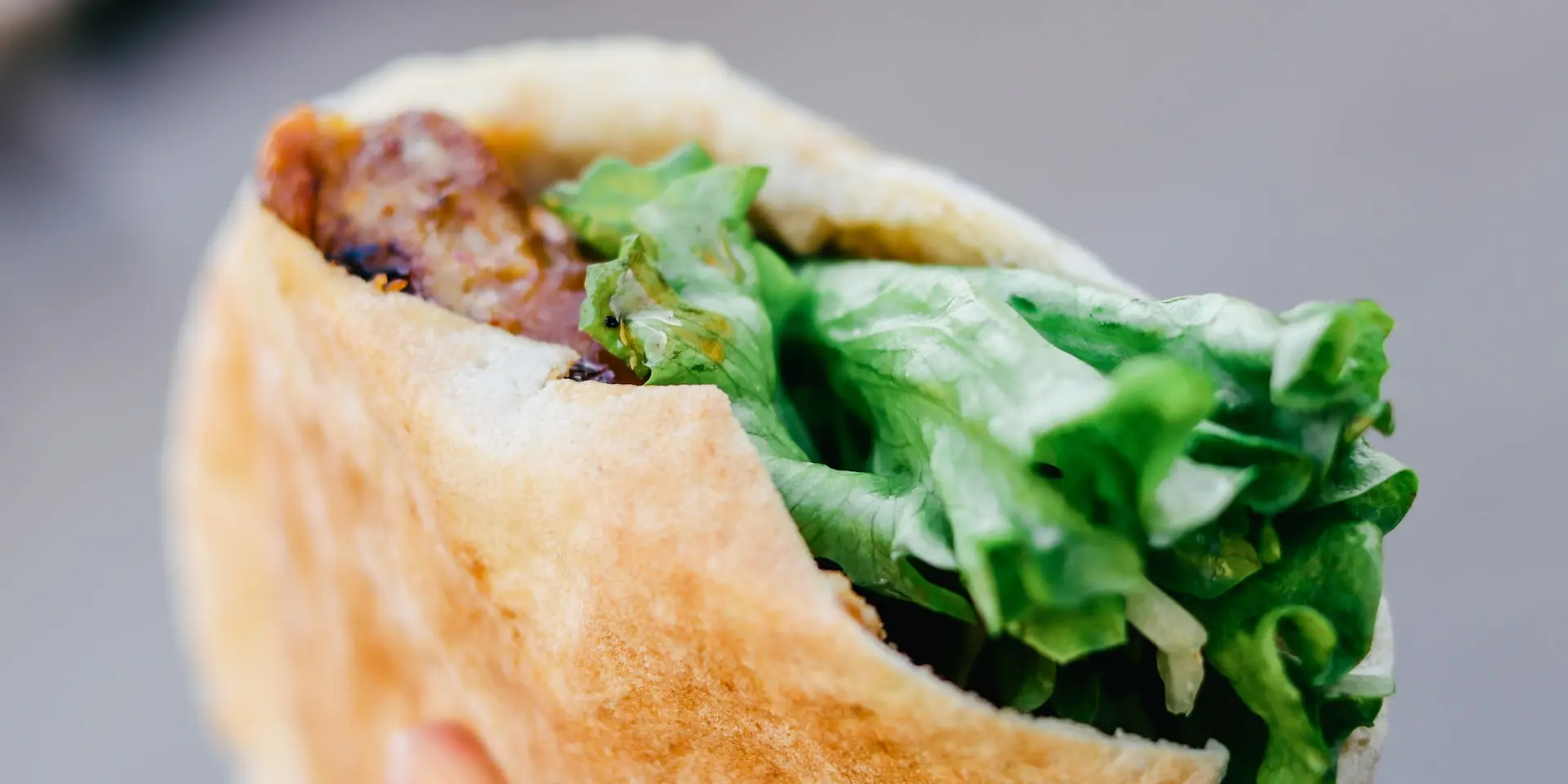Pitta bread is a type of flatbread that is traditionally made from a yeasted dough. It is typically round or oval in shape, and has a pocket in the center that can be filled with various fillings.
What is Pitta Bread?
Updated:

Photo by Sandie Clarke on Unsplash
Table of Contents
The pitta bread has its roots in ancient Middle Eastern cultures. Pitta bread is one of the oldest types of bread still eaten by today’s world, with remnants of it dating back over 14,000 years ago in the Middle Eastern state of Jordan.
Pitta is made with the four staples of leavened bread ingredients: yeast, water, flour, and salt. You must bake pitta bread at fairly high temperatures, which causes the release of steam in the dough that creates the pitta’s famous puffy pocket
The modern pitta bread is historically considered a Greek recipe found in modern Mediterranean dishes. Since its birth, the pitta bread has become an international cuisine.
You can eat pitta in a variety of ways, as a sandwich, wrap, or alone. Favorite methods of eating pitta include pitta dipped in hummus or olive oil, pitta used for lamb or beef gyros, or even using pitta as a base for the breakfast falafels loved in Turkey.
The History of Pitta Bread
The world owes the Greeks for a great many things. From the Olympics to indoor plumbing, the Greeks shaped the world we live in today. Any bread-loving person in the world knows that the Greeks invented one of the greatest types of bread still eaten to this day: the pitta bread.
Pitta, or pitta, traces its origins back to 14,500 years ago, when the Natufian culture that stood where the country of Jordan stands today, made flatbreads out of cereal grains. However, the pitta bread evolved to have something different than its ancestor, the pitta has pockets.
This pocket launched the pitta bread into the stratosphere of culinary cuisine in what stands now as the Mediterranean, Arabic, and Middle Eastern world. In the time of the Persian and Greek empires, the pitta bread became the Everyman’s bread, serving as utensil and food.
The dual-role of pitta made it a frequent fair in the armies of Alexander the Great and Xerxes of Persia. The pocket held meat and vegetables for the soldiers to munch on during their marches to conquer the known world.
The pitta bread grew to become a social matter. The backyard ovens and community kitchens originating in ancient Arabic and Mediterranean culture still exist today, and hundreds of pitta loaves bake as community members gather over their communal cooking.
Pitta bread did not arrive in the United States until the swathes of Greek and Arabic immigrants began arriving at Ellis Island and other ports during the 19th Century. The bread did not see its popularity in the U.S. rise until the 1970s when ethnic food was all the rage in the states.
The low-fat and sugar qualities of pitta bread made it popular in the skinny-driven market of the 1970s. At the beginning of the 1990s, pitta bread became are an eighty-million-dollar industry. It remains a popular choice with bread lovers everywhere!
Ingredients in Pitta Bread
Pitta bread traditionally only has 4 ingredients:
- Flour
- Yeast
- Salt
- Water
Pitta Bread Nutritional Information
Pitta bread is fairly nutritional but heavy on carbs. An average serving of pitta bread has 33 grams of carbs per one piece, 11% of a person’s daily needs. But, pitta is exceptionally low in fat, has 5% of a person’s daily needed amount of Calcium, Iron, and Magnesium.
Approx values based on a 100g portion.
How to Make Pitta Bread
You can make pitta even if you’re just a beginning baker. Simply allow the yeast, sugar, and water to mix until frothy, then mix in your ingredients until a ball of dough forms. Knead the dough for a few minutes, then allow the dough to proof for up to eight hours (or overnight.)
Once proofed, punch the dough flat and separate it into balls, then shape the dough for baking. To bake pita bread, you can either use a stovetop skillet or a pre-heated baking tray.
To bake using an oven, you heat the baking tray in the oven at about 400-425 degrees Fahrenheit. Remove the tray from the oven and place the pitta dough on it, two minutes on each side, until puffy. You may need to reheat the tray between batches.
To bake using a pan, simply place the dough in a heated skillet, and bake for two minutes on each side. You typically should serve the pitta warm.
Pitta Bread Recipes
Pitta bread variations typically occur in the fillings of the bread, or with additives such as olive oil and herbs in the dough.
For a fun twist on pizza, add basil and olive oil to your dough, and fill the pitta pocket with your favorite pizza toppings after the dough has baked
If you’re a fan of sweet treats, add cinnamon, sugar, and butter to your pitta dough. Serve the pitta hot, with cream cheese frosting or more cinnamon and butter to create your own twist on cinnamon rolls!
Pitta Bread FAQ's
Pitta bread is thought to have originated in the Middle East, and is now popular in many Mediterranean and Middle Eastern countries.
Pitta bread can be eaten plain, or it can be filled with various savory or sweet fillings. It can also be cut into strips and used as a dipping bread.
Some popular pitta bread fillings include hummus, tabbouleh, falafel, and various meats and vegetables.
Pitta bread is generally considered to be a healthy food choice, as it is low in fat and calories. Additionally, the whole wheat variety of pitta bread provides beneficial fiber and nutrients.
Pitta bread can be stored at room temperature in a sealed bag or container. It can also be frozen for up to 3 months.
Pitta bread can be reheated by wrapping it in foil and placing it in a preheated oven for 10-15 minutes.
What are some pitta bread recipes?
Pitta bread can be made from a simple yeasted dough. Once the dough has risen, it is shaped into rounds or ovals and then baked.
Pitta bread is thought to have originated in the Middle East, and has been eaten for centuries. It was traditionally made from a unleavened dough, but the yeasted variety has become more popular in recent years.
Pitta bread is typically baked in an oven. Once the dough has been shaped into rounds or ovals, place it on a baking sheet and bake at a high temperature until it is cooked through.
Yes, pitta bread is vegan as it does not contain any animal products.
No, pitta bread is not gluten free as it contains wheat flour. However, there are some brands that offer gluten free pitta bread.
Pitta bread is generally a healthy food choice as it is low in fat and calories. Additionally, the whole wheat variety of pitta bread provides beneficial fiber and nutrients.
If you can not eat pitta bread, there are several substitutes that can be used, including flatbreads, tortillas, or even rice papers.
Yes, pitta bread can be frozen for up to 3 months.
Pitta bread will last for several days at room temperature if it is stored in a sealed bag or container. However, if pitta bread is frozen, it will last for up to 3 months.
In English, both "pita" and "pitta" are accepted spellings for the type of flatbread. "Pita" is more commonly used in American English, while "pitta" is often used in British English.
